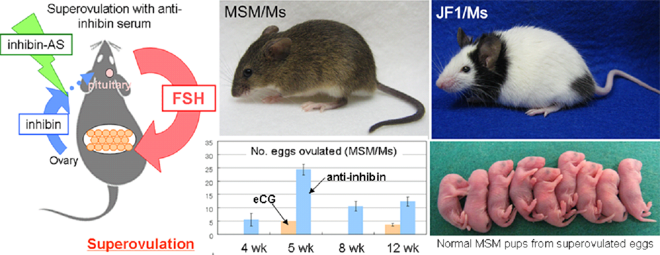 |
BRC Current Technology August 2012 |
5. Superovulation with anti-inhibin serumToward efficient preservation and use of wild-derived strains |
|
| Ovulation in mammals is hormonally regulated by the pituitary-gonadal axis. Normally, one to 10 mature oocytes are ovulated from the ovaries, depending on the species. To make the best use of female animals for the studies of reproductive biology and developmental biology, they are usually administered with hormones to ovulate excessive numbers of oocytes; i.e., the so-called superovulation treatment. For superovulation of laboratory mice, the combination of equine chorionic gonadotropin (eCG) and human chorionic gonadotropin (hCG) generally works well because eCG has an FSH-like activity and stimulates folliculogenesis in mice. However, many wild-derived strains poorly respond to this treatment by unknown causes. Recently, we have found that treatment with anti-inhibin serum instead of eCG was effective for superovulation of wild-derived strains. Since inhibin suppresses FSH secretion from the pituitary, the anti-inhibin treatment is expected to increase the endogenous FSH secretion. In MSM/Ms and JF1/Ms strains, most popular wild-derived strains at our center, this treatment resulted in five fold increase in the number of ovulated oocytes (from about 5 to 25). These oocytes developed normally after in vitro fertilization and were safely cryopreserved at the 2-cell stage. At our center, many of other wild-derived strains have been successfully cryopreserved by this technique. In addition, we have improved the embryo transfer technique for efficient production of wild-derived mice. Maintenance of wild-derived strain has been one of the biggest challenges at our center. Now they can be safely preserved in LN2 and efficiently distributed to researchers by request. They would provide unique experimental animal models for the future biomedical researches. (Bioresource Engineering Division, RIKEN BRC)
| |
| Reference: Hasegwa et al., Biol. Reprod. 86(5):167, 1-7. Print 2012 | |
| Comment in: Ward MA, Biol. Reprod. 86(5):168, 1-2. Print 2012 | |





